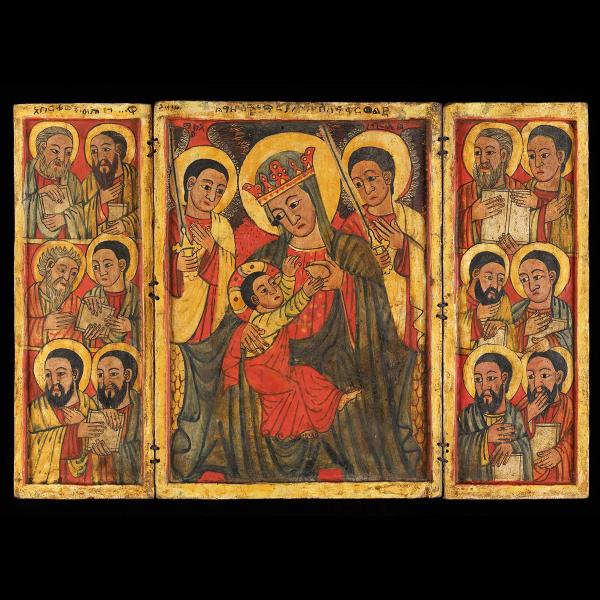Panel Painting with the Crowned Nursing Virgin and the Twelve Apostles
Artwork Details
- Title: Panel Painting with the Crowned Nursing Virgin and the Twelve Apostles
- Date: second half 15th century
- Culture: Ethiopian (Ethiopia)
- Medium: Paint on wood
- Dimensions: 11 1/4 × 16 5/16 × 13/16 in. (28.5 × 41.5 × 2 cm)
Mount: 2 1/2 in. × 11 1/4 in. × 16 in. (6.4 × 28.6 × 40.6 cm). The mount has a post that will likely be 1 in. - Classification: Paintings-Icons
- Credit Line: National Museum of African Art, Smithsonian Institution, Washington, D.C., Gift of Joseph and Patricia Brumit; Conservation of this work supported by the Smithsonian Institution Women’s Committee (2004-7-1)
- Rights and Reproduction: Photograph by Franko Khoury
- Curatorial Department: Medieval Art and The Cloisters
Audio

548. Panel Painting with the Crowned Nursing Virgin and the Twelve Apostles
Solomon Kibriye, Ethiopian Orthodox Tewahedo Deacon
NARRATOR: This wooden triptych stood in a private prayer corner in an Ethiopian household or in a prayer chapel in a church. A pair of angels with drawn swords watch over the Virgin mother and nursing Christ child, while on the outer panels, the presence of the twelve apostles indicates that this celebrates the Virgin’s assumption into heaven, a feast day in the Ethiopian Orthodox Church.
SOLOMON KIBRIYE: My name is Solomon Kibriye. I'm a deacon of the Ethiopian Orthodox Tewahedo Church; I serve in the Church of our Savior in the Bronx.
The Christ Child nursing from the Virgin Mary was very popular in the Ethiopian Church for a long time, it's a very moving image.
NARRATOR: Painted in the fifteenth century, this sacred image blends local and foreign imagery, as Ethiopian iconographers traveling around the Byzantine empire brought ideas home from other cultures. In most Ethiopian icons the Virgin holds the baby in her left arm, placing her in a secondary position at Christ's right side, but here he’s on her right.
KIBRIYE: Other than slight indications of foreign influence, it seems like a very typically Ethiopian icon—the faces being full forward, and not in profile—in Ethiopian iconography, only evil people were painted in profile.
The colors are very typical of Ethiopian iconography. The features are Ethiopian. That’s what people were familiar with. You’ll see the short afro hairstyle on the men, especially angels.
But when you see these saints, it’s almost that they’re nonracial. Their skin tone is not one that’s found in nature. It’s kind of a golden tone that’s supposed to show that inner divinity, that light of blessedness.